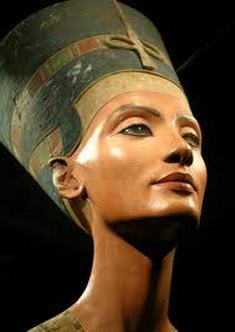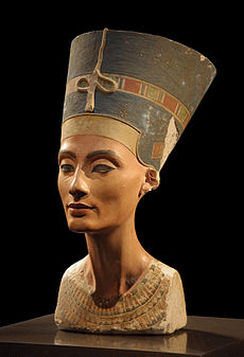Queen Nefertiti

Ancient Egyptian Queen Nefertiti - also called Neferneferuaten
Lived around: c. 1370 BC c. 1330 BC
Nefertiti was the Great Royal Wife of the Egyptian Pharaoh Akhenaten (also known as: King Akhenaton) Nefertiti and her husband were known for a religious revolution, in which they started to worship one god only. She played a prominent role in the cult of the sun god, this was Aten (also know as: Aton), or the sun disc.
Nefertiti was born in Thebes, Egypt. But Nefertiti's parentage is unrecorded, some believe she was of Egyptian blood, while others believe she was a foreign princess, as her name translates as “A Beautiful Woman Has Come” early Egyptologists believed that she must have been a princess from Mitanni (Syria). There is strong circumstantial evidence, however, to suggest that she was the Egyptian-born daughter of the courtier Ay, brother of Akhenaton's mother, Tiy.
When Nefertiti was fifteen years old, she married Amenhotep IV - who changed his nam e later to Akhenaten, who was a year older and became king upon his father's death. They had six daughters and, according to some, one son within 10 years of her marriage, the elder three being born at Thebes, the younger three at Tell el-Amarna. Two of her daughters became queens of Egypt.
Lived around: c. 1370 BC c. 1330 BC
Nefertiti was the Great Royal Wife of the Egyptian Pharaoh Akhenaten (also known as: King Akhenaton) Nefertiti and her husband were known for a religious revolution, in which they started to worship one god only. She played a prominent role in the cult of the sun god, this was Aten (also know as: Aton), or the sun disc.
Nefertiti was born in Thebes, Egypt. But Nefertiti's parentage is unrecorded, some believe she was of Egyptian blood, while others believe she was a foreign princess, as her name translates as “A Beautiful Woman Has Come” early Egyptologists believed that she must have been a princess from Mitanni (Syria). There is strong circumstantial evidence, however, to suggest that she was the Egyptian-born daughter of the courtier Ay, brother of Akhenaton's mother, Tiy.
When Nefertiti was fifteen years old, she married Amenhotep IV - who changed his nam e later to Akhenaten, who was a year older and became king upon his father's death. They had six daughters and, according to some, one son within 10 years of her marriage, the elder three being born at Thebes, the younger three at Tell el-Amarna. Two of her daughters became queens of Egypt.

During the first five years of Amenhotep's reign, Nefertiti enjoyed a high profile. Evidence of her political importance is seen in the large number of carved scenes in which she is shown accompanying him during ceremonial acts. She is shown taking part in the daily worship and making offerings. The earliest images of Nefertiti come from the Theban tombs of the royal butler Parennefer and the vizier Ramose, where she is shown accompanying her husband. In the Theban temple known as Hwt-Benben (“Mansion of the Benben Stone”; the benben was a cult object associated with solar ritual), Nefertiti played a more prominent role, usurping kingly privileges in order to serve as a priest and offer to the Aton. A group of blocks recovered from Karnak (Luxor) and Hermopolis Magna (Al-Ashmunayn) shows Nefertiti participating in the ritual smiting of the female enemies of Egypt. She wears her own unique headdress—a tall, straight-edged, flat-topped blue crown.
In the fourth year of his reign Amenhotep IV decided to move the capital to Akhetaten (modern Amarna). In his fifth year, Amenhotep IV officially changed his name to Akhenaten, and Nefertiti was henceforth known as Neferneferuaten-Nefertiti. The name change was a sign of the ever-increasing importance of the cult of the Aten. It changed Egypt's religion from a polytheistic religion to a religion which may have been better described as a monolatry (the depiction of a single god as an object for worship)
Mysterious disappearance: After the fourteenth year of Akhenaten's rule, there are no more pictures of Nefertiti; she simply disappears from view. Some believe she was the power behind the throne and thus responsible for the changes during the rule of Akhenaten until being dismissed from her position and banished to the North Palace at Amarna. This would mean there was a conflict within the royal family, with Nefertiti favoring the continued worship of Aten while Akhenaten and his son-in-law Tutankhamen supported a return to the worship of Amen-Ra. Most scholars, however, now suppose that Nefertiti's disappearance may simply be due to the fact that she died - theories include sudden death by a plague that was sweeping through the city or another natural death. This theory is based on the discovery of several shabti fragments inscribed for Nefertiti (now located in the Louvre and Brooklyn Museums) - and one of the king's other wives took her place at his side. A more dramatic, if less accepted, theory holds that she assumed a new, masculine identity toward the end of Akhenaten's rule—that Nefertiti and the young Smenkhkare, who ruled briefly either with or after Akhenaten and is believed by some to have been his son, were in fact the same person.
In the fourth year of his reign Amenhotep IV decided to move the capital to Akhetaten (modern Amarna). In his fifth year, Amenhotep IV officially changed his name to Akhenaten, and Nefertiti was henceforth known as Neferneferuaten-Nefertiti. The name change was a sign of the ever-increasing importance of the cult of the Aten. It changed Egypt's religion from a polytheistic religion to a religion which may have been better described as a monolatry (the depiction of a single god as an object for worship)
Mysterious disappearance: After the fourteenth year of Akhenaten's rule, there are no more pictures of Nefertiti; she simply disappears from view. Some believe she was the power behind the throne and thus responsible for the changes during the rule of Akhenaten until being dismissed from her position and banished to the North Palace at Amarna. This would mean there was a conflict within the royal family, with Nefertiti favoring the continued worship of Aten while Akhenaten and his son-in-law Tutankhamen supported a return to the worship of Amen-Ra. Most scholars, however, now suppose that Nefertiti's disappearance may simply be due to the fact that she died - theories include sudden death by a plague that was sweeping through the city or another natural death. This theory is based on the discovery of several shabti fragments inscribed for Nefertiti (now located in the Louvre and Brooklyn Museums) - and one of the king's other wives took her place at his side. A more dramatic, if less accepted, theory holds that she assumed a new, masculine identity toward the end of Akhenaten's rule—that Nefertiti and the young Smenkhkare, who ruled briefly either with or after Akhenaten and is believed by some to have been his son, were in fact the same person.
The Bust

Nefertiti was made famous by her bust, now in Berlin's Neues Museum, shown to the right. The bust is one of the most copied works of ancient Egypt. It was attributed to the sculptor Thutmose, and it was found in his workshop. The bust is notable for exemplifying the understanding Ancient Egyptians had regarding realistic facial proportions.
Nefertiti had many titles including:
Lady of all Women
Sweet of Love
Hereditary Princess
Great of Praises
Lady of Grace
Lady of The Two Land
Main King’s Wife
Great King’s Wife
and, Mistress of Upper and Lower Egypt
Nefertiti's place as an icon in popular culture is secure as she has become somewhat of a celebrity. After Cleopatra she is the second most famous "Queen" of Ancient Egypt in the Western imagination and influenced through photographs that changed standards of feminine beauty of the 20th century, and is often referred to as
"the most beautiful woman in the world".
Nefertiti had many titles including:
Lady of all Women
Sweet of Love
Hereditary Princess
Great of Praises
Lady of Grace
Lady of The Two Land
Main King’s Wife
Great King’s Wife
and, Mistress of Upper and Lower Egypt
Nefertiti's place as an icon in popular culture is secure as she has become somewhat of a celebrity. After Cleopatra she is the second most famous "Queen" of Ancient Egypt in the Western imagination and influenced through photographs that changed standards of feminine beauty of the 20th century, and is often referred to as
"the most beautiful woman in the world".
A Poll has taken place to know which King/Queen of Old Egypt
people are mostly interested to know more about his/her life.
150 voters participated, 7 choices were available: "King Tut, King Ramses ll, King Akhenaten, Queen Hatshepsut, Queen Tiye, Queen Nefertiti, any Other" But, Queen Nefertiti had 36% of the votes.
You can also take part in our Polls,
Click on this picture to go to current Poll and Vote!
Kindly let us know if you "like" the biography. Thanks
people are mostly interested to know more about his/her life.
150 voters participated, 7 choices were available: "King Tut, King Ramses ll, King Akhenaten, Queen Hatshepsut, Queen Tiye, Queen Nefertiti, any Other" But, Queen Nefertiti had 36% of the votes.
You can also take part in our Polls,
Click on this picture to go to current Poll and Vote!
Kindly let us know if you "like" the biography. Thanks

